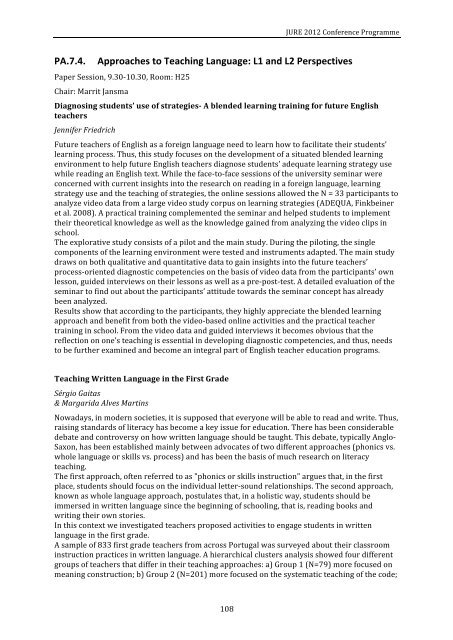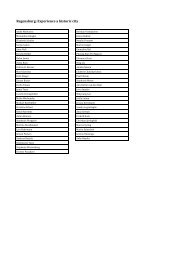JURE 2012 Programme book - EARLI Jure 2012
JURE 2012 Programme book - EARLI Jure 2012
JURE 2012 Programme book - EARLI Jure 2012
Create successful ePaper yourself
Turn your PDF publications into a flip-book with our unique Google optimized e-Paper software.
108<br />
<strong>JURE</strong> <strong>2012</strong> Conference <strong>Programme</strong><br />
PA.7.4. Approaches to Teaching Language: L1 and L2 Perspectives<br />
Paper Session, 9.30-‐10.30, Room: H25<br />
Chair: Marrit Jansma<br />
Diagnosing students’ use of strategies-‐ A blended learning training for future English<br />
teachers<br />
Jennifer Friedrich<br />
Future teachers of English as a foreign language need to learn how to facilitate their students’<br />
learning process. Thus, this study focuses on the development of a situated blended learning<br />
environment to help future English teachers diagnose students’ adequate learning strategy use<br />
while reading an English text. While the face-‐to-‐face sessions of the university seminar were<br />
concerned with current insights into the research on reading in a foreign language, learning<br />
strategy use and the teaching of strategies, the online sessions allowed the N = 33 participants to<br />
analyze video data from a large video study corpus on learning strategies (ADEQUA, Finkbeiner<br />
et al. 2008). A practical training complemented the seminar and helped students to implement<br />
their theoretical knowledge as well as the knowledge gained from analyzing the video clips in<br />
school.<br />
The explorative study consists of a pilot and the main study. During the piloting, the single<br />
components of the learning environment were tested and instruments adapted. The main study<br />
draws on both qualitative and quantitative data to gain insights into the future teachers’<br />
process-‐oriented diagnostic competencies on the basis of video data from the participants’ own<br />
lesson, guided interviews on their lessons as well as a pre-‐post-‐test. A detailed evaluation of the<br />
seminar to find out about the participants’ attitude towards the seminar concept has already<br />
been analyzed.<br />
Results show that according to the participants, they highly appreciate the blended learning<br />
approach and benefit from both the video-‐based online activities and the practical teacher<br />
training in school. From the video data and guided interviews it becomes obvious that the<br />
reflection on one’s teaching is essential in developing diagnostic competencies, and thus, needs<br />
to be further examined and become an integral part of English teacher education programs.<br />
Teaching Written Language in the First Grade<br />
Sérgio Gaitas<br />
& Margarida Alves Martins<br />
Nowadays, in modern societies, it is supposed that everyone will be able to read and write. Thus,<br />
raising standards of literacy has become a key issue for education. There has been considerable<br />
debate and controversy on how written language should be taught. This debate, typically Anglo-‐<br />
Saxon, has been established mainly between advocates of two different approaches (phonics vs.<br />
whole language or skills vs. process) and has been the basis of much research on literacy<br />
teaching.<br />
The first approach, often referred to as "phonics or skills instruction" argues that, in the first<br />
place, students should focus on the individual letter-‐sound relationships. The second approach,<br />
known as whole language approach, postulates that, in a holistic way, students should be<br />
immersed in written language since the beginning of schooling, that is, reading <strong>book</strong>s and<br />
writing their own stories.<br />
In this context we investigated teachers proposed activities to engage students in written<br />
language in the first grade.<br />
A sample of 833 first grade teachers from across Portugal was surveyed about their classroom<br />
instruction practices in written language. A hierarchical clusters analysis showed four different<br />
groups of teachers that differ in their teaching approaches: a) Group 1 (N=79) more focused on<br />
meaning construction; b) Group 2 (N=201) more focused on the systematic teaching of the code;



